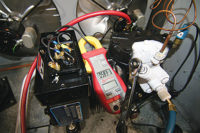Lower temperature refrigeration applications often experience frost on their suction lines, compressor’s end bell, and/or part of the compressor’s head. On air-cooled compressors, the part of the compressor’s head that gets coldest is where the suction vapors enter before they are compressed (See Figure 1 - top, first image). On refrigerant-cooled compressors, the compressor’s end bell is where refrigerant suction gasses enter and will often accumulate frost (See Figure 2 - top, second image). These parts often get cold enough to reach a temperature below the dew point temperature of the surrounding air and form frost.
Frosty Conditions
Frost is nothing but frozen dew. When the air’s dew point temperature is reached from coming in contact with the cold suction line, compressor’s end bell, or compressor head, water vapor in the air is cooled below its dew point and will condense. When this condensed water vapor reaches 32°F, it will freeze into frost. So, frost is simply condensed water vapor or dew that has reached 32°F and below.
Many service technicians believe that if there is heavy frost on the suction line or end bell of the compressor, or if there is frost creeping up onto the compressor’s head, there is cause for alarm. This is simply not true.
Figure 1 is a low-temperature commercial refrigeration application operating with 7°F of evaporator superheat and 40°F of compressor superheat. The refrigerated box temperature is 0°F with an evaporator temperature of -13° F, and the system uses R-404A as the refrigerant. With an evaporator temperature of -13°F and the system having 40°F of compressor superheat, the temperature of the refrigerant coming into the compressor was 27°F (-13°F plus 40°F). The 27°F temperature coming into the compressor is lower than the surrounding air’s dew point temperature and also lower than the freezing point of water (32°F), so the dew on the suction line, end bell, and/or compressor’s head will often form frost. These frost patterns are completely normal for low-temperature refrigeration applications.
Flooding is liquid refrigerant coming back to the compressor’s crankcase during a run cycle, while slugging is liquid refrigerant or oil actually entering the compressor’s cylinders and/or valve arrangement and being pumped. Because the system has superheat at the compressor of 40°F, flooding and slugging cannot exist. In addition, the system has a compressor superheat of 40°F, so there is no worry about whether the compressor is flooding or slugging. In order for slugging or flooding to occur, the compressor would have to be experiencing no superheat. In other words, the temperature coming into the compressor would be the same as the evaporator temperature (-13°F). This would indicate that there was no compressor superheat and liquid refrigerant was entering the compressor.
In either scenario, whether the system has compressor superheat and doesn’t have compressor superheat, both the suction line, end bell, and/or compressor’s head would still be frosted. This is why it is of utmost important for service technicians to measure superheat at both the evaporator and compressor to make sure the compressor is protected from slugging and flooding.
The Importance of Superheat
Compressor superheat, or total superheat, is all of the superheat in the low side of the refrigeration system. Compressor superheat consists of evaporator superheat and suction line superheat. A service technician can measure total superheat by placing a temperature measuring device at the compressor inlet and taking the temperature. A pressure reading will also be needed at this same location.
Consider the example above for an R-404A system with a low-side pressure taken at the compressor of 21 psig or -13°F and a compressor inlet temperature of 27°F. The pressure gauge reading on the low side of the system of 21 psig tells the service technician that there is a -13°F evaporating temperature. The compressor superheat calculation is as follows:
27°F compressor inlet temperature - (-13°F) evaporator temperature = 40°F compressor superheat
In this example, the compressor superheat is 40°F. It is possible to have a TXV adjusted to control the proper amount of evaporator superheat at the coil and still return liquid refrigerant to the compressor at certain low load conditions. It is recommended that all TXV-controlled refrigeration systems have some compressor superheat to ensure that the compressor does not see liquid refrigerant (flood or slug) at low evaporator heat loadings. The TXV, however, should be set to maintain proper superheat for the evaporator.
The service technician may want to consult with the compressor manufacturer to see what the maximum return gas temperature and/or compressor superheat is recommended for the application in question. Following these instructions should ensure that the compressor will always see refrigerant vapor.









